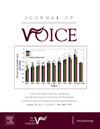Survey of Referral Patterns in Southwestern Mainland China: How Do Pediatricians Manage Children with Dysphonia
IF 2.5
4区 医学
Q1 AUDIOLOGY & SPEECH-LANGUAGE PATHOLOGY
引用次数: 0
Abstract
Objective
Voice disorders are common in children and have a negative impact on their quality of life. However, presently, voice assessment and therapy are inaccessible in most pediatric departments of Mainland China. Thus, referring pediatric patients with voice disorders to otolaryngology is warranted for prompt and appropriate treatment. The purpose of this study is to investigate referral patterns and their influencing factors for pediatricians’ managing children with dysphonia in Southwestern Mainland China.
Study Design
Observational study.
Methods
A 28-item questionnaire was designed by multidisciplinary experts, and an anonymous survey was performed online via Wenjuanxing between September 8, 2021 and October 8, 2021. The statistical analyses were performed using the independent sample median test, the linear/logistic regression model, the Kruskal–Wallis test, and Spearman's correlation test to determine any statistically significant relationships between the variables of interest.
Results
Predominantly recruited from institutions in Southwestern China, 368 pediatricians were surveyed. (1) The majority of the pediatricians reported that ≤10% of children sought medical help for voice disorders; (2) only 22.1% of the pediatricians’ hospitals had equipment for evaluating voice disorders; (3) 74.6% of the pediatricians would refer children with dysphonia to otolaryngology, and the older pediatricians were more likely to refer their patients than were the younger pediatricians (P = 0.022); (4) in the group that would make a referral (n = 250), the pediatricians who had worked longer (P = 0.037) and practised in the Grade-A tertiary hospitals (P = 0.044) were more likely to trust their experience as a reason for making a referral. For each year worked the probability of referring children with dysphonia depending on the pediatrician's experience increased by 3.4%.
Conclusion
Although the pediatricians encountered some barriers to diagnosing voice disorders, their attitude towards making referrals was positive. The age and work duration of the pediatricians and the hospital grade were the influencing factors in the referral patterns. Further publicity of vocal hygiene, ongoing education among Chinese pediatricians and the improvement of referral systems may be most useful for better managing children with dysphonia.
中国西南地区转诊模式调查:儿科医生如何管理发音障碍儿童?
目的:嗓音障碍是儿童的常见病,对儿童的生活质量有负面影响。然而,目前中国大陆大多数儿科都无法进行嗓音评估和治疗。因此,有必要将嗓音障碍的儿童患者转诊至耳鼻喉科,以获得及时、适当的治疗。本研究旨在调查中国西南地区儿科医生处理发音障碍儿童的转诊模式及其影响因素:研究设计:观察性研究:方法:由多学科专家设计28个项目的调查问卷,于2021年9月8日至2021年10月8日期间通过文娟星进行匿名在线调查。统计分析采用独立样本中位数检验、线性/逻辑回归模型、Kruskal-Wallis检验和Spearman相关检验,以确定相关变量之间是否存在显著的统计学关系:受访的 368 名儿科医生主要来自中国西南地区的医疗机构。(1)大多数儿科医生表示,≤10%的儿童因嗓音障碍而就医;(2)仅有22.1%的儿科医生所在医院拥有评估嗓音障碍的设备;(3)74.6%的儿科医生会将发音障碍儿童转诊至耳鼻喉科,年龄较大的儿科医生比年龄较小的儿科医生更有可能转诊患者(P = 0.022);(4)在会转诊的群体(n = 250)中,工作时间较长(P = 0.037)且在甲级三甲医院执业(P = 0.044)的儿科医生更有可能将自己的经验作为转诊的理由。根据儿科医生的经验,每工作一年,转诊发音障碍儿童的概率就会增加3.4%:尽管儿科医生在诊断嗓音疾病时遇到了一些障碍,但他们对转诊的态度是积极的。儿科医生的年龄、工作时间和医院级别是影响转诊模式的因素。进一步宣传嗓音卫生知识、在中国儿科医生中开展持续教育以及改善转诊系统可能对更好地管理发音障碍儿童最有帮助。
本文章由计算机程序翻译,如有差异,请以英文原文为准。
求助全文
约1分钟内获得全文
求助全文
来源期刊

Journal of Voice
医学-耳鼻喉科学
CiteScore
4.00
自引率
13.60%
发文量
395
审稿时长
59 days
期刊介绍:
The Journal of Voice is widely regarded as the world''s premiere journal for voice medicine and research. This peer-reviewed publication is listed in Index Medicus and is indexed by the Institute for Scientific Information. The journal contains articles written by experts throughout the world on all topics in voice sciences, voice medicine and surgery, and speech-language pathologists'' management of voice-related problems. The journal includes clinical articles, clinical research, and laboratory research. Members of the Foundation receive the journal as a benefit of membership.
 求助内容:
求助内容: 应助结果提醒方式:
应助结果提醒方式:


